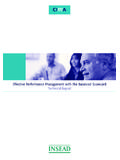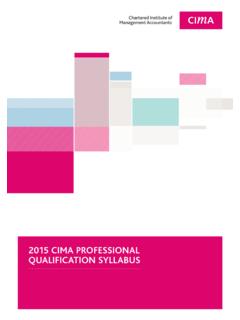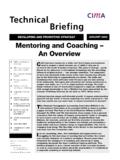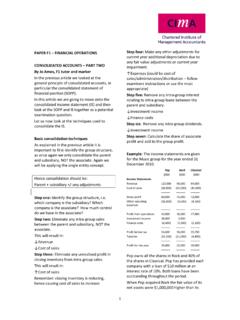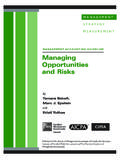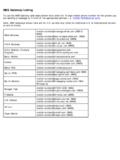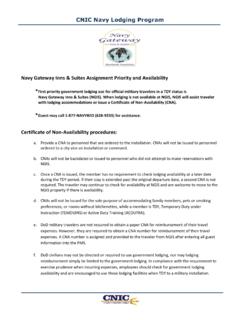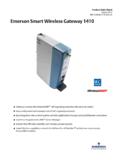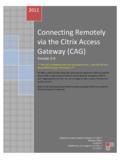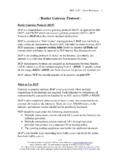Transcription of Standard Costing and Variance Analysis Topic …
1 Topic Gateway Series Standard Costing and Variance Analysis Standard Costing and Variance Analysis Topic Gateway Series No. 24. 1. Prepared by Stephanie Edwards-Nutton and Technical Information Service Revised March 2008. Topic Gateway Series Standard Costing and Variance Analysis About Topic Gateways Topic Gateways are intended as a refresher or introduction to topics of interest to CIMA members. They include a basic definition, a brief overview and a fuller explanation of practical application. Finally they signpost some further resources for detailed understanding and research. Topic Gateways are available electronically to CIMA members only in the CPD. Centre on the CIMA website, along with a number of electronic resources.
2 About the Technical Information Service CIMA supports its members and students with its Technical Information Service (TIS) for their work and CPD needs. Our information specialists and accounting specialists work closely together to identify or create authoritative resources to help members resolve their work related information needs. Additionally, our accounting specialists can help CIMA. members and students with the interpretation of guidance on financial reporting, financial management and performance management, as defined in the CIMA. Official Terminology 2005 edition. CIMA members and students should sign into My CIMA to access these services and resources. The Chartered Institute of Management Accountants 26 Chapter Street London SW1P 4NP.
3 United Kingdom T. +44 (0)20 8849 2259. F. +44 (0)20 8849 2468. E. 2. Topic Gateway Series Standard Costing and Variance Analysis Standard Costing and Variance Analysis Definition and concept Standard cost 'The planned unit cost of the product, component or service produced in a period. The Standard cost may be determined on a number of bases. The main use of Standard costs is in performance measurement, control, stock valuation and in the establishment of selling prices.'. CIMA Official Terminology, 2005. Variance Analysis The evaluation of performance by means of variances, whose timely reporting should maximise the opportunity for managerial action.'. CIMA Official Terminology, 2005. Context In the current CIMA syllabus students will learn and may be examined on this Topic in Paper C1, Fundamentals of Management Accounting and in Paper 1, Management Accounting Performance Evaluation.
4 Study systems for these papers are available from CIMA Publishing. Related concepts Cost accounting, performance measurement; budgeting and control Alternative concepts Activity based Costing , throughput accounting, marginal Costing . Overview and comparison Standard Costing is a control system that enables any variances from Standard cost or budget to be analysed in some detail. This allows for more effective cost control. 3. Topic Gateway Series Standard Costing and Variance Analysis A Standard Costing system consists of the following four elements: 1. Setting standards for each operation. 2. Comparing actual with Standard performance. 3. Analysing and reporting variances arising from the difference between actual and Standard performance.
5 4. Investigating significant variances and taking appropriate competitive action. Standard Costing and Variance Analysis application Standard Costing This is generally best suited to organisations with repetitive activities. It is probably most relevant to manufacturing organisations with repetitive production processes. Standard Costing cannot be applied easily to non-repetitive activities because there is no clear basis for observing and recording operations. It is difficult to determine a clear Standard . Two commonly used approaches are used to set Standard costs. 1. Past historical records can be used to estimate labour and material usage. 2. Engineering studies can be used. This may involve a detailed study or observation of operations in terms of material, labour and equipment usage.
6 The most effective control is achieved by identifying standards for quantities of material, labour and services to be used in an operation, rather than an overall total product cost. Variances from Standard on all component parts of cost should be reported to identify the cause and ultimate responsibility for the Variance from Standard . Variance Analysis Variance Analysis involves breaking down the total Variance to explain: 1. How much of it is caused by the usage of resources differing from the Standard 2. How much is caused by cost of resources differing from the Standard Together, variances can help to reconcile the total cost difference by comparing actual and Standard cost. The main purpose of variances is to provide reasons for off- Standard performance.
7 In this way, management can improve operations, correct errors and deploy resources more effectively to reduce costs. 4. Topic Gateway Series Standard Costing and Variance Analysis Direct material standards and Variance Analysis Direct material standards are derived from the amount of material required for each product or operation. This should take into account the most suitable material for the product specification and design. It should also include any anticipated wastage or losses in the process. Direct material standards should also consider the Standard price of the material, based on the most suitable and competitive price as required by the most suitable quality of material. These prices should also include economic order quantity, discounts and credit terms offered by suppliers.
8 The Standard material used and the Standard cost of the material are combined to calculate the Standard material cost. By comparing the actual material price and the actual material used with the standards calculated, the material price and the material usage Variance can be determined. Material mix and yield variances The direct material usage Variance measures the change in total material cost caused by using a non- Standard amount of material in production. It is also possible to subdivide this Variance into a direct material mix Variance and a direct material yield Variance . This is mostly undertaken in process industries where a Standard input mix is the norm. Identifiable components of input are combined during production to produce an output in which the individual components are no longer separately identifiable.
9 It is sometimes necessary to vary the input mix. As a result, this may lead to an output from the process that will differ from what was expected. The material mix Variance therefore measures the change in cost caused by an alteration to the constituents of the input mix. The material yield Variance measures the change in cost brought about by any deviation in output from the Standard process output. Direct labour standards and Variance Analysis Direct labour standards are derived from the Analysis of activities required for different operations. Often a time and motion study is carried out to determine the most efficient production method, including operating conditions, equipment required and best practice.
10 5. Topic Gateway Series Standard Costing and Variance Analysis Following this, the time is analysed to determine the Standard hours required to complete an operation. Standard wage rates are identified using rates of pay for employees required to carry out the operation, which are normally set by the company. This Standard time and Standard wage rate are combined to calculate the Standard labour rate. Overhead standards variable overheads Where overheads vary with activities, a Standard variable overhead rate is used. However, several different activity measures exist and it is important for the organisation to identify which measure influences overhead cost the most. For example, volume related variable overheads could vary with direct labour, machine hours, material quantities or number of units.


